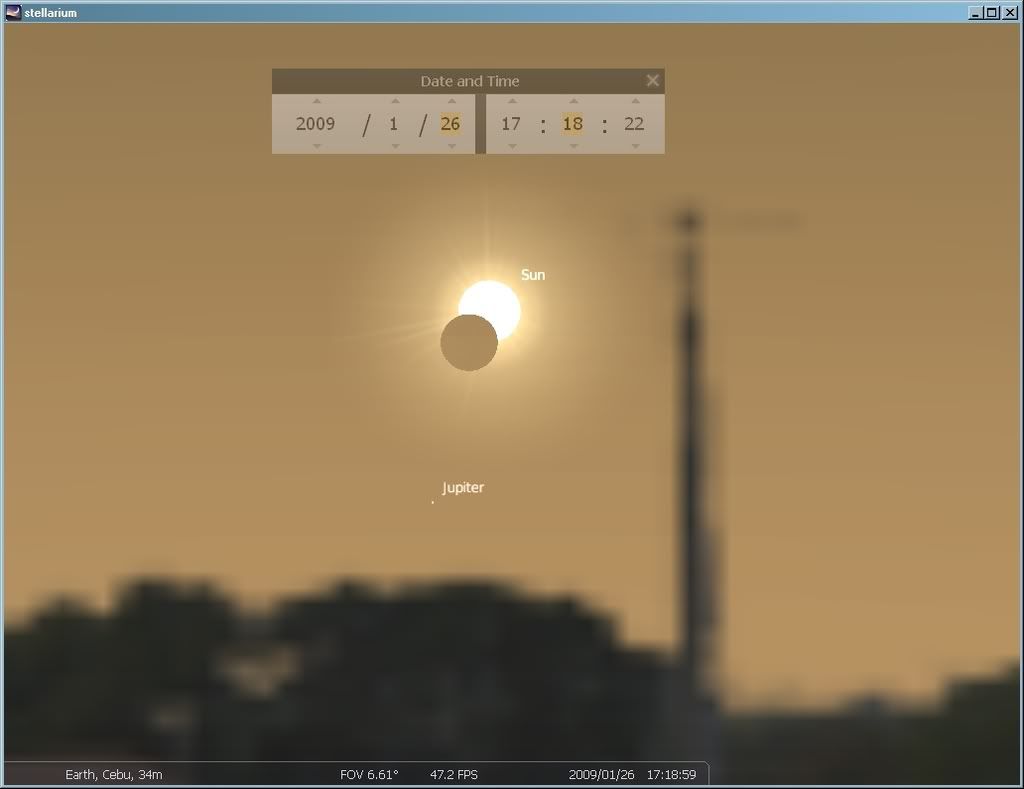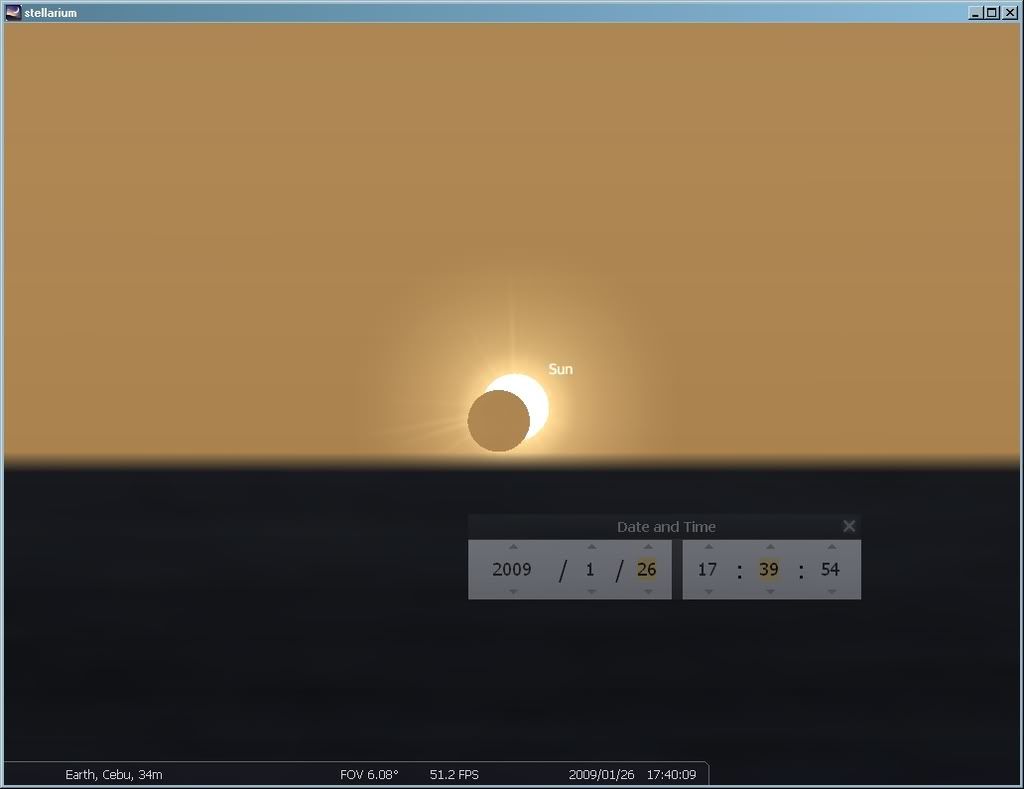(thanks to Divemaster for the heads up)
There will be a partial solar eclipse on Monday, Jan. 26, 2009.
The moon's disk will make contact with the sun's disk at around 4:53 PM. But you won't notice the moon's dark edge til around 5:00-5:05PM.
This image is a snapshot from Stellarium 0.10.0-BETA, showing what the sun-moon looks like at around 5: 18PM, over the western mountains of Cebu.
To me, the best place to observe and photograph this event is any place in Cebu where the you can see the sun setting into the sea. For example, here's what the event might look like at Balamban (again using Stellarium 0.10.0-BETA) at around 5:28 PM.
Since the setting sun is not obstructed by mountains, you can see the sun-moon duo, set into the sea.
There will be no "totality" observed from the Philippines. In addition, although the moon will indeed cross the face of the sun if you are in some part of Indonesia or Borneo, the moon is farther away from the earth, and thus it will not completely block the sun's disk, and thus the sky will NOT become dark as night, as in the case of a TOTAL solar eclipse. This type of disk crossing (which some refer to as a "Heroes Type Eclipse") is in fact called an Annular Solar Eclipse.
ATTENTION:
Sun - Wikipedia, the free encyclopedia
This is both a warning and disclaimer. Looking directly into the sun is a POTENTIALLY DANGEROUS activity. I believe a pair of strongly tinted sunglasses can do the trick, kay late afternoon na man, however, I DO NOT RECOMMEND IT. Therefore, I STRONGLY SUGGEST you use WELDER'S GLASS. You can buy these sa hardware store, barato ra man siguro ni.
Again, you have been cautioned. Please do not blame me if something happens to your eyes--I already gave out the precautions!
SAFETY UPDATE:
1) Colored Water Cellophane is NOT acceptable for direct viewing. While you feel it's comfortable, harmful infrared/UV radiation can still damage your retina. I'm using colored Cellophane ONLY for photography purposes.
2) There is another way to view the event indirectly and SAFELY. All you need is a piece of cardboard, some aluminum foil, a needle, and a piece of bond paper.
Get two pieces of cardboard--one piece colored white to project onto. Cut a square in one cardboard, then tape a piece of foil over the square. Now make a pinhole in the middle of the foil.
With the sun behind you, hold the pinhole cardboard as far from the white cardboard as you can. Remember, the farther you are from the screen, the bigger your image. (from Exploratorium: the museum of science, art and human perception )
-RODION
Results 1 to 10 of 48
-
01-25-2009, 03:01 PM #1
 Partial Solar Eclipse, Jan. 26 (Monday Late Afternoon) 2009
Partial Solar Eclipse, Jan. 26 (Monday Late Afternoon) 2009
Last edited by rodsky; 01-26-2009 at 11:32 AM.
-
01-25-2009, 03:07 PM #2
-
01-25-2009, 03:10 PM #3

You are welcome...tsk tsk tsk ga-ulan ra ba ron da...I hope clear skies ta ugma.
-RODION
-
01-25-2009, 04:07 PM #4
-
01-25-2009, 04:12 PM #5

wew! may jud unta clear skies ta ugma. makakita cguro ta ani kng naa ta sa 40th floor sa club ultima.
-
01-25-2009, 04:51 PM #6
-
01-25-2009, 04:55 PM #7

ATTENTION:
Sun - Wikipedia, the free encyclopedia
This is both a warning and disclaimer. Looking directly into the sun is a POTENTIALLY DANGEROUS activity. I believe a pair of strongly tinted sunglasses can do the trick, kay late afternoon na man, however, I DO NOT RECOMMEND IT. Therefore, I STRONGLY SUGGEST you use WELDER'S GLASS. You can buy these sa hardware store, barato ra man siguro ni.
Again, you have been cautioned. Please do not blame me if something happens to your eyes--I already gave out the precautions!
SAFETY UPDATE:
1) Colored Water Cellophane is NOT acceptable for direct viewing. While you feel it's comfortable, harmful infrared/UV radiation can still damage your retina. I'm using colored Cellophane ONLY for photography purposes.
2) There is another way to view the event indirectly and SAFELY. All you need is a piece of cardboard, some aluminum foil, a needle, and a piece of bond paper.

Get two pieces of cardboard--one piece colored white to project onto. Cut a square in one cardboard, then tape a piece of foil over the square. Now make a pinhole in the middle of the foil.
With the sun behind you, hold the pinhole cardboard as far from the white cardboard as you can. Remember, the farther you are from the screen, the bigger your image. (from Exploratorium: the museum of science, art and human perception )
-RODIONLast edited by rodsky; 01-26-2009 at 11:33 AM.
-
01-25-2009, 05:13 PM #8
-
01-25-2009, 05:19 PM #9

Sa may Sabah, North Borneo, Borneo proper, and parts of Indonesia. Or if you're in a boat in the middle of the Indian Ocean
 Basin pod sa may Sulu or Tawi-tawi, pero the sun would be setting by then.
Basin pod sa may Sulu or Tawi-tawi, pero the sun would be setting by then.
Animation of Annular Solar Eclipse, January 26, 2009
-RODION
-
01-25-2009, 05:49 PM #10
Similar Threads |
|






 Reply With Quote
Reply With Quote

